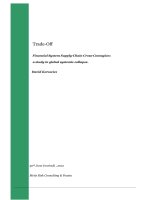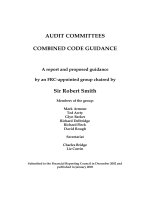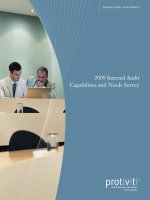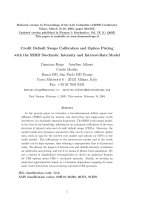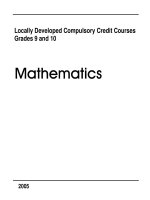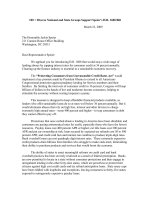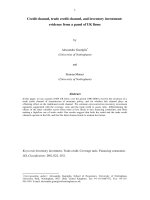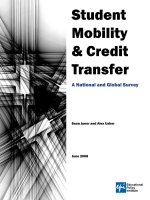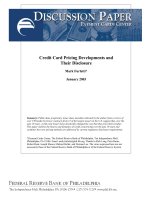Student Mobility & Credit Transfer: A National and Global Survey pot
Bạn đang xem bản rút gọn của tài liệu. Xem và tải ngay bản đầy đủ của tài liệu tại đây (872.05 KB, 53 trang )
Student
Mobility
& Credit
Transfer
A National and Global Survey
Sean Junor and Alex Usher
June 2008
Student Mobility and Credit Transfer:
A National and Global Survey
By Sean Junor and Alex Usher
This paper was originally produced for the Canadian Council on Learning
as a background paper for their 2007 publication Post-Secondary Education
in Canada: Strategies for Success. The Educational Policy Institute thanks
the Council for its financial support in the preparation of this document.
The Educational Policy Institute is a non-profit organization based in
Virginia Beach, Virginia with offices in Toronto, Ontario and Melbourne,
Australia. EPI is dedicated to the study of issues related to the expansion of
quality educational opportunities. Visit www.educationalpolicy.org for
more information.
Copyright 2008 Educational Policy Institute. Contents may be photocopied
and distributed with attribution.
EducationalPolicyInstitute
2
Introduction
Technological advances in communication and transportation have
increased educational opportunities for post-secondary education students
around the globe. Individuals and information now travel quicker and
cheaper between countries and continents. Post-secondary institutions no
longer have a local, jurisdictional or even domestic focus; their vision is
global. Furthermore, governments and employers recognize that the
workforce of the future must include well-trained, globally aware
professionals with international work experience who can solve economic
and social problems. At the same time, students and faculty are becoming
increasingly interested in spending time in different academic environments,
often in foreign surroundings. The length of stay can range from one
semester to the pursuit of a full academic credential.
A proper protocol (or mechanism) designed to recognize previous academic
performance is essential in ensuring a full range of student mobility options.
It is for this reason that credit transfer and student mobility are linked.
Credit transfer systems provide the lubricant to ensure seamless academic
mobility. Therefore, the purpose of this paper is to explain student mobility
and credit transfer in a conjoined fashion.
The first half of the paper will center on student mobility and what it means
to the post-secondary system. The barriers which prevent the free flow of
students from jurisdiction to jurisdiction will also be focused upon.
Additional sections will examine the role finance, information and most
importantly – academics – play in the restriction of opportunity. Next, the
paper will investigate measures designed by post-secondary institutions and
governments to assist increased mobility opportunities. The mobility
section will end with a detailed analysis of the Canadian performance on
select mobility measures and provide additional information on the mobility
picture in the main international post-secondary education systems (e.g.
United States and the United Kingdom).
The second half of the paper will examine how post-secondary education
credits act as a form of knowledge “currency” and how the issue of credit
recognition is best seen as a policy issue which requires the “exchange” of
one institution’s credits into a currency that other institutions can freely
accept. It will examine how credit transfer works in various Canadian
jurisdictions, the role played by Credit Transfer Councils in certain
jurisdictions and how transfer information is ultimately conveyed to the
student, parent, guidance counsellor or post-secondary institution. Finally, a
detailed analysis of credit transfer systems in Europe, Australia, New
Zealand, the United Kingdom, the United States and the European Union
will be provided.
EducationalPolicyInstitute
3
PartI:StudentMobility
Student mobility is defined as any academic mobility which takes place
within a student’s program of study in post-secondary education. The
length of absence can range from a semester to the full program of study.
There are two main types of student mobility: mobility for an entire
program of study (diploma or degree mobility); and for part of a program
(credit mobility). This paper will examine the latter two types of mobility.
Students studying in multiple academic settings believe that a series of
benefits will accrue from their studies. These individuals may, for example,
be interested in strengthening their personal development, increasing their
academic opportunities or enhancing their career prospects. Mobile
students believe that a diversified education provides them with increased
confidence, maturity, linguistic competence and academic ability. Exposure
to other cultural surroundings is also perceived as being important (King
2004, Malysheva 2005). Higher education institutions likewise benefit from
student mobility. The learning environment for all students is often greatly
enhanced, as returning students and incoming exchange students bring an
added dimension to the classroom.
European countries have benefited for the past two decades from a regional
student mobility initiative known as Erasmus (European Action Scheme for
the Mobility of University Students). This program, which will be discussed
in greater detail later in the paper, is the operational framework for the
European Commission's initiatives in higher education and in some cases
makes transfer of credit across national borders easier than transfer of
credits within them. As a result, a number of European countries (e.g.
United Kingdom) are revisiting (or recently have revisited) their student
mobility policies to encourage mobility internally and throughout the
European Union (EU) to build off the success of Erasmus. These countries
are also trying to expand the influx of students from their former colonies
and reach out to new markets.
In the Asia-Pacific region, institutions can join the UMAP (University
Mobility in Asia Pacific) program designed to promote regional student
mobility. UMAP membership includes over 30 countries, territories, and
special administrative regions. This membership also includes 24 American
institutions – located in 16 different states.
BarrierstoStudentMobility
Barriers to student mobility are not entirely different from barriers
preventing individuals from attending post-secondary education in general.
Youth who choose not to go on to post-secondary education cite a variety
Mobilestudents
believethata
diversifiededucation
providesthemwith
increasedconfidence,
maturity,linguistic
competenceand
academicability.
EducationalPolicyInstitute
4
of reasons for their decision. Roughly three major “sets” of barriers effect
these decisions. These are, in order of increasing importance:
information/motivation, financial, and academic (Junor and Usher 2004).
Insufficient information on study possibilities outside one’s local area may
prevent students from studying away from home. With respect to semester
or year-abroad opportunities, home and host institutions often do not
provide enough information on mobility opportunities and do not assure
students that they will receive the necessary support before going abroad,
during their studies at foreign institutions and after their return. Many
qualified students may fear that they could lose academic standing by taking
different credits at another institution.
Lack of adequate financial resources may also be a very important factor in
a student’s decision not to leave home in order to attend PSE. The issue of
finances refers not only to a shortage of money; it also pertains to student
lifestyles (in particular, part-time employment that students are afraid to
lose by going elsewhere) and future issues (e.g., students can lose tuition
fees paid to their home university if they go to study elsewhere). However,
financial support can be provided to minimize the influence of financial
barriers, and students can receive funding to cover their expenses from
institutions and national or international funds.
Academic barriers to mobility largely consist of two main components –
lack of academic qualification and the absence of credit recognition. Post-
secondary students face the demand for different academic qualifications
required for entry into programs abroad – this is likely less of an issue for
those students interested in taking courses or credits only for a short period
of time.
The second issue, which will be explored in full later in the paper, is non-
transferability of credits. Post-secondary students maybe reluctant to
attempt a semester or year away from their home institution if they are not
certain they will receive full credit value for their studies.
There are a few additional barriers that prevent full mobility inside an
increasingly global post-secondary system. General language proficiency
and cultural integration (culture shock) often hold individuals back from
choosing to study abroad. The issue of cultural integration is not limited to
students studying abroad. It is also a common barrier for many first-
generation, visible-minority or Aboriginal students inside various countries,
including Canada.
Generallanguage
proficiencyand
culturalintegration
(cultureshock)often
holdindividualsback
fromchoosingto
studyabroad.
EducationalPolicyInstitute
5
Financial Measures Promoting Student Mobility
We will return to issues of academic barriers to mobility in Part II of this
paper, which deals with credit transfer. Credit transfer is not the only
barrier that governments and other funders can play in role in helping
students to overcome. As noted above, financial barriers to mobility are
also substantial, but private foundations, post-secondary institutions and
governments all provide varying levels of support to encourage or enhance
post-secondary student mobility throughout home countries and around the
globe. There are two main categories of student aid programs designed to
encourage mobility–portable aid targeting intra-state (i.e. domestic) mobility
and portable aid targeting inter-state (i.e. international) mobility.
Domestic mobility programs do not appear to be a priority for many
national or local governments. In fact, in many parts of the world there are
actually financial barriers erected for non-local, domestic students in the
form of differential tuition fees.
Student aid designed to increase international mobility, on the other hand,
is relatively widespread. The four best examples of this type of aid are the
Fulbright US Student Program, the Chevening Scholarship in the United
Kingdom, Australian Scholarships and the financial component of the EU’s
Erasmus program, all of which were designed to promote global mobility.
The Fulbright U.S. Student Program is the largest American exchange
program offering opportunities for students and young professionals to
undertake international graduate study, advanced research, university
teaching, and teaching in elementary and secondary schools worldwide.
Approximately 3,500 students from over 150 countries receive Fulbright
awards including 1,200 American students from all fields of study.
The Chevening Scholarships program is the premier British government
scholarships scheme for international students. Chevening is funded by the
Foreign and Commonwealth Office in the United Kingdom. Significant
contributions are also made by UK higher education institutions, the private
sector, other government departments and devolved administrations (i.e.
the Welsh and Scottish governments). The program is administered by the
British Council and assists over 1,700 students annually with a scholarship
budget of just over £33.4 million ($76.5 million) (Foreign and
Commonwealth Office 2006).
Australian Scholarships is an initiative of the Australian Government to
promote education cooperation and development in the Asia-Pacific region.
There are three main components of this merit-based award program:
Development Scholarships – undergraduate and graduate, Leadership
Awards – postgraduate and fellowships and the Endeavour programme. In
2006, the Australian government committed an additional A$1.4 billion
EducationalPolicyInstitute
6
($1.32 billion CDN) to the program to assist an additional 19,000 top flight
students from around the region until 2011. The maximum award available
is A$250,000 ($235,000 CDN) for PhD programs.
The Erasmus program provides European students with the
opportunity to study outside their home country in another European
country for a period of between three and 12 months. Each year
approximately 140,000 students receive grants to study inside Europe
at various institutions. The program has an annual budget of €190
million ($294.5 million CDN) to support students.
It should be noted, however, that this is not the only form of assistance
available to EU residents who move from one country to another. EU law
requires every country to treat nationals from other EU countries identically
to citizens of its own when it comes to issues such as social assistance. As a
result, students who move from one country to another are also eligible to
benefit from the host country’s student financial aid system (this is the
inverse of student aid mobility provisions in Canada, where provinces are
required to treat their own citizens identically regardless of where they
study). Depending on the relative generosity of the student aid systems of
the student’s home and destination country’s student aid systems, this can
be a very important source of support as well.
Canada provides very little of either type of aid. Programs designed to
facilitate intra-national mobility are few and far between. There are only two
truly notable examples of this type of activity. The first is the Council of
Ministers of Education (CMEC) Explore bursary program – which offers
students an opportunity study in a second language inside of Canada. The
second is the Canadian Merit Scholarship Foundation (CMSF) program.
Though the CMSF does not have inter-provincial mobility as one of its
main goals, the fact that it grants $75,000 scholarships over four years and
stipulates leaving home as one of the de facto conditions of the award,
makes it this country’s closest thing to a financial mobility incentive.
Canadian student aid designed to promote global mobility is largely
disjointed and often consists of very modest sums of money. Many
Canadian colleges and universities (e.g. University of Ottawa’s Student
Mobility fund and University of British Columbia Student Mobility Awards)
have one-off scholarships and awards to encourage students to take a
semester or year abroad. Canadian provinces and territories (e.g. The
Ministry of Education of Quebec Student Mobility Bursary program) also
EducationalPolicyInstitute
7
offer some financial measures to support students pursing a portion of their
studies abroad.
Results: Data on Student Mobility
Data Limitations
Student mobility, whether it be inward mobility (i.e., from one domestic
institution to another) or outward mobility (i.e., Canadian students studying
abroad), can be difficult to measure. Statistics Canada’s data collection in
this area is notably deficient in this area. Canadian post-secondary
institutions, particularly community colleges, report unit record data to
Statistics Canada in an inconsistent manner. Some institutions report
various student characteristics (e.g., age, gender and province of origin),
while others report only the total number of students enrolled, making
additional analysis on the aggregate file impossible. Statistics on student
mobility therefore need to be viewed with caution, as they can only
approximate, rather than reflect, the real situation.
The state of knowledge on Canadian students pursing credits or credentials
abroad is even worse. There is no single accessible database tracking such
developments. The credit data reside with each Canadian institution that
has established agreements with international institutions. The Association
of Universities and Colleges of Canada collects information from its
members and has constructed the Canadian University International
Exchange Agreements Database (CUE). Data on credentials are best
accessed through either the Institute for International Education (IIE) or
UNESCO – but neither one is considered infallible. Until 2001, the IIE
published data on the number of Canadians studying in the U.S. by state
and by institution, but the data are no longer available due to security
concerns. As a result, it is largely unclear how Canada compares with other
educational world leaders in terms of student mobility.
The various Canadian survey instruments from which data on barriers to
post-secondary education can be extrapolated – e.g., School Leavers’
Survey/School Leavers’ Follow-up Survey (SLS/SLF), 2000 Youth in
Transition Survey (YITS), 2002 Post-Secondary Education Participation
Survey (PEPS) – have never asked students directly about mobility barriers.
For all the flaws in Canadian data collection, the collection and availability
of data from other countries is often a problem as well, especially when it
comes to ensuring cross-nationally comparable statistics. For example, it is
unclear whether comparable local and national data is finding its way to
various international datasets- UNESCO, OECD and EUROSTAT.
Various studies (Lanzendorf and Teichler 2003 and Kelo et al 2006) have
Thestateof
knowledgeon
Canadianstudents
pursingcreditsor
credentialsabroadis
evenworse.Thereis
nosingleaccessible
databasetracking
suchdevelopments.
EducationalPolicyInstitute
8
identified the problem as larger than just a national one. Many European
countries (and increasingly Canada) are not reporting highly relevant and
politically sensitive data at all. Furthermore, data quality differs strikingly by
level of post-secondary education. Finally, the lack of uniform definitions
on all post-secondary education terms presents a problem to the user and
the reader.
Canadian mobility data
There are several potential metrics by which to measure the degree of
student mobility in Canada. Traditionally, it has been measured in terms of
inter-provincial mobility (which is the only statistic regularly tracked by
Statistics Canada), but this is a fairly restrictive definition of mobility. It
could equally be measured as the percentage of students who move away
from their parents’ home to study or the percentage who move more than a
certain distance away from their parents’ home. Students moving abroad to
study is also a factor in the mobility equation. The sections below look at
mobility from each of these perspectives.
Leaving home to study in Canada
At the most basic level of mobility – that is, simply moving from away from
the parental home in order to study - the Canadian Undergraduate Survey
Consortium (2005) and the Canadian College Student Survey (2005) both show
that approximately 40 per cent of college and university students live away
from their parents. According to the undergraduate survey consortium data
this figure appears to be largely unchanged over the past six years.
Another pair of Canadian studies have further investigated student
relocation patterns for academic pursuits. The 2003-04 EKOS Canadian
post-secondary student financial survey Investing in Their Future: A Survey of
Student and Parental Support for Learning and the Canada College Student Survey
provide the best available data on this subject. According to the EKOS
survey, just over one-third of post-secondary students – including 38
percent of university students and 21 percent of college students - indicated
that they moved from one city to another to attend a post-secondary
institution.
These studies also show that students who relocate are most likely to be in
their mid-20s. In fact, four in ten students between 20 and 25 years of age
reported moving. Younger students (under 18) were the least likely to move
(17 per cent), while students aged over 30 were only slightly more likely to
do so (20 per cent). This is not surprising, since the majority of older
students would be fairly settled in their lives, while younger students, in part
due to the significant number of college students (including those attending
CEGEPs in Quebec) who are less likely to need to move for school.
Fourintenstudents
between20and25
yearsofagereported
moving.Younger
students(under18)
weretheleastlikely
tomove(17percent),
whilestudentsaged
over30wereonly
slightlymorelikelyto
doso(20percent).
EducationalPolicyInstitute
9
Inter-Provincial Student Flows
Students often choose to study outside of their province of residence, for
many reasons – a desire to move away from home, a desire to study in a
program unavailable in their province of residence, etc. As indicated above,
this decision is much more common among university students than college
students.
At the university level, just over one in ten students leaves his or her
province of origin to study; at the college level, the number is not much
more than one in 50. The number for university students has risen
somewhat over the past decade, but for most of the past 20 years the
proportion of students studying out of province has remained within the
range of eight to ten per cent. The most recent available figures suggest that
the number is now 12 per cent, but the rise in this percentage has been
accompanied by a rise in the percentage of students whose origin is
“unknown” or “unreported,” so the increase may be due to data irregularity
rather than actual changes.
Table 1 below describes the in- and out-migration of full-time university
students for all provinces in the 2003-04 academic year. The data in this
table show that the majority of jurisdictions (i.e., seven of ten) are net
“exporters” of students, and only three provinces (New Brunswick, Nova
Scotia and Quebec) “import” more students than they “export”.
Table1–Full‐TimeCanadianUniversityStudentMigrationin2003‐04a
Province
Totalnumberof
students
Totalnumberof
studentsarrivingto
study
Totalnumberof
studentsleavingto
study
Netgain(+)orloss
(‐)
Out‐of‐province
studentsasa
percentageoftotal
enrolment
NL 14,446 1,179 2,342‐1,163 8%
PE 3,251 608 1,628‐1,020 20%
NS 36,237 10,627 4,397 6,230 29%
NB 21,123 4,862 4,460 402 23%
QC 161,775 12,687 5,988 6,699 8%
ON 313,654 15,550 17,115‐1,615 5%
MB 27,846 1,183 1,921
‐738 4%
SK 26,479 1,205 2,278
‐1,073 5%
AB 65,034 4,985 5,272
‐287 8%
BC 65,754 2,260 9,695
‐7,435 3%
Source: Association of Universities and Colleges of Canada
Note:
a
The number of students currently labelled as having home residence of “unknown” or “not applicable” is quite high. The problem is
particularly noticeable in the provinces of Alberta and British Columbia, where the University of Alberta and Simon Fraser University block reported
significant segments of data under these categories in 2003-2004.
EducationalPolicyInstitute
10
Generally speaking, students who leave their province in order to study
tend not to travel too far. As Table 2 shows, in most provinces the major
sources of out-of-province students are the neighbouring provinces. Nearly
half of all Newfoundland and Labrador students who leave the province go
to nearby Nova Scotia, while Ontario attracts 80 per cent of all Quebec
university students who leave their province. In all jurisdictions except the
Yukon, Ontario is one of the top three destinations for students leaving
their home province to study. Newfoundland and Labrador, Prince Edward
Island and Manitoba are not among the top three destinations for students
from any other province. Alberta is the major destination of students
leaving the territories to attend university.
Table2–PreferredDestinationsofOut‐of‐ProvinceUniversityStudentsin2003‐04
ArrivingtoStudy LeavingtoStudy
Jurisdiction 1 2 3 1 2 3
NF
ON(395) NS(316) NB(137) NS(1,259) NB(461) ON(371)
PE NS(216) NB(176) ON(91) NS(705) NB(562) ON(202)
NS ON(4,612) NB(2,314) NF(1,259) NB(1,905) ON(1,200) QC(543)
NB NS(1,905) ON(1,110) PE(562) NS(2,314) ON(886) QC(856)
QC ON(8,084) BC(1,784) NB(856) ON(4,937) NB(428) NS(324)
ON QC(4,937) BC(4,169) AB(2,300) QC(8,084) NS(4,612) BC(1,117)
MB ON(511) SK(292) BC(175) ON(836) AB(337) SK(254)
SK AB(472) BC(296) MB(254) AB(893) ON(599) MB(292)
AB BC(2,356) ON(1,052) SK(893) ON(2,300) QC(794) BC(741)
BC ON(1,117) AB(741) QC(125) ON(4,169) AB(2,356) QC(1,784)
Source: Association of Universities and Colleges of Canada
As noted above, data on college student migration patterns suffer from
massive institutional under-reporting and data gaps, particularly from
institutions in the western provinces. In the absence of comprehensive data,
very little pan-Canadian analysis can be performed. Nevertheless, on the
basis of the available data, some facts can be ascertained. Virtually all
college students from Quebec (99 per cent) and Ontario (98 per cent) come
from within the province – in other words, almost no one in either of these
provinces goes to another province to pursue college studies. Prince
Edward Island, a major exporter of university students, is a major importer
of college students: nearly 20 per cent of Holland College’s students come
from outside the province.
EducationalPolicyInstitute
11
International Students Flows to and From Canada
Studying abroad, as discussed earlier, can greatly enhance the value of a
student’s education. A student studying outside his or her city, province or
country of residence has the opportunity to gain all kinds of important
insights into cultural or global issues, acquire new skills and abilities, and
perhaps learn a second or third language. The skills acquired while studying
abroad subsequently benefit both the individual and society at large.
According to the International Student Mobility Report compiled by the
Sussex Centre for Migration Research (2004), students who have studied
abroad often pursue a higher degree, have a greater chance of employment
upon graduation and also have a greater chance of entering a degree-related
job, having a professional occupation status, and earning upwards of
£20,000 ($50,000 CDN) per annum.
According to data from UNESCO, the number of Canadian students
studying abroad has nearly doubled over the past a decade. In 1990-91,
there were just under 20,000 Canadians studying abroad at the tertiary level,
and by 2001-02 (the last year for which data are available), the number had
grown to just under 39,000. It is unclear how many of these students have
left Canada to pursue an entire degree and how many are simply going
abroad for a year or a semester, as UNESCO data do not distinguish
between students in these two situations.
By far the most popular international study destination for Canadian
students is the United States – almost 70 per cent of Canadian students
studying abroad are located in the U.S. This is down from five years earlier,
when over 75 per cent of Canadians abroad were studying in the U.S. The
share of foreign U.S. students who are Canadian has remained constant for
over a decade, at five per cent. According to Open Doors: Report on
International Educational Exchange, Canada is the fifth-ranked place of
origin for students coming to the U.S and is the only non-Asian country in
the top five.
The United Kingdom, which now hosts over three times as many Canadian
students as it did ten years ago, is the second-most chosen destination for
international study. In third place is Australia where over 3,000 Canadian
students now study (a figure which has increased by a factor of 20 over the
past decade). Fewer than 800 Canadians choose to study abroad in non-
OECD countries.
Accordingtodata
fromUNESCO,the
numberofCanadian
studentsstudying
abroadhasnearly
doubledoverthepast
adecade.In1990‐91,
therewerejustunder
20,000Canadians
studyingabroadat
thetertiarylevel,and
by2001‐02,the
numberhadgrownto
justunder39,000.
EducationalPolicyInstitute
12
Table3–DestinationsofCanadianStudentsStudyingAbroadfrom1993‐94to2003‐04
Country 1993‐94 1998‐99 2003‐04
UnitedStates 22,665 22,746 27,017
UnitedKingdom 1,287 3,342 3,890
Australia 150
a
1,267 3,100
France 1,091 1,005 1,267
Germany 425
a
446 556
Allothercountries 1,672 N/A N/A
Total 27,437 30,255
a
N/A
Source: UNESCO’s Statistical Yearbook (annual) and UNESCO Institute for Statistics
Notes:
a
Estimates for OECD countries only.
Measuring students coming into Canada should be a relatively easy matter,
but different sources provide wildly different estimates. Statistics Canada
data suggests that the number of foreign students studying at Canadian
universities was just over 62,000 and the number at Canadian colleges was
roughly 7,500. UNESCO, on the other hand, reports 138,000 coming to
Canada to study. It is possible that the discrepancy is explained by the
presence of in the UNSECO numbers of students arriving to study for
short terms at private language schools.
United States mobility data
Interstate migration
Interstate college student mobility is more common among American post-
secondary students than it is in Canada. According to the National Center
for Education Statistics 2004 Digest, close to 20 percent of American
freshman relocate to the another state to study. Close to 450,000 freshman
now cross state lines each year to pursue degrees, despite the presence of
financial disincentives like out-of-state tuition fees.
The majority of inter-state student migration is consolidated in three main
areas. The first is the Northeast, where a large number of prestigious private
schools are located and a commute across state lines is a short drive. The
second are the two large Southern states of Texas and Florida. Though
neither take a high percentage of their students from out of state, their large
absolute size means they contain tens of thousands of out-of-state students.
The third destination area is California. Like Texas and Florida, it does not
take in a large percentage of its students from out-of-state; however, over
20,000 out-of-state freshman a year move to the state to study. Table 4
shows the top five and bottom 5 states by percentage for out of state
university freshman.
EducationalPolicyInstitute
13
Table4–Top5andBottom5StatesbyPercentageforOutofStateFreshmanUniversityStudents(2003‐2004)
State PercentageofStudentsfromOutofState TotalNumberofStudents
DistrictofColumbia 90percent 11,350
Vermont 68percent 6,343
RhodeIsland 59percent 15,388
NewHampshire 48percent 12,430
NorthDakota 42percent 9,477
NewJersey 8percent 57,564
Texas 8percent 205,221
Michigan 9percent 88,078
California 11percent 259,869
Alaska 12percent 2,760
Source: National Center for Education Statistics
Studies have shown that out-of-state migration rates are positively affected
by the presence of large population centers, well-funded higher education
systems, and selective public and private colleges and universities. Family
income is a positive predictor of a student’s likelihood to migrate out of
state. Student migrants are likely to follow in the footsteps of friends,
relatives and classmates and attend out-of-state colleges they have heard
about through word of mouth (Western Interstate Commission on Higher
Education 2005).
These numbers have been constant for the past decade and could likely be
much higher if not for a few state policy rules that likely restrict interstate
mobility. The state policy rules are targeted at increasing access to local
opportunities and not geared towards increasing student choice beyond
state borders.
Unlike in Canada, state student aid program funds are not fully portable;
fewer than ten jurisdictions make their student aid portable. Also, many
states, similar to Quebec and Nova Scotia, employ differential tuition fees1
and those fees for out-of-state residents continue to rise at rates faster than
those for state residents. State student financial aid programs continue to
expand, supported with federal matching funds, though these programs still
tend to be limited to state residents.
1
There are reciprocal tuition agreements (13) between states and student exchange
programs coordinated by regional state agencies, however, they are the exception
not the rule.
EducationalPolicyInstitute
14
International students and Americans studying abroad
For the past 60 years, more students studying abroad have made the United
States their destination than any other country. In 2005, there were over
half a million international students enrolled in American community
colleges and universities, which represents nearly a quarter of all students
studying abroad worldwide. Though there were small declines in student
numbers after September 11, 2001 and its resultant tightening of
immigration rules, student numbers have again stabilized and indeed are
rising once again. Almost 60 percent of these students come from Asia,
two-thirds of which come from India, Japan, China, and Korea).
Just over 200,000 Americans choose to study abroad each year. The United
Kingdom is the number one destination (close to 16 percent) for American
post-secondary students outside their home country and close to 12 percent
chose to study in Italy – the second most popular destination spot for
Americans. The remaining three most popular destinations are: Spain,
France and Australia.
Other international examples
Australia
The last three decades have seen significant growth in the number of
international students arriving to study at Australian post-secondary
education institutions. In the mid-1980s less than five percent of the total
student population (or approximately 13,000 international students) were
enrolled in Australian higher education. By 2005, it was estimated that
almost 170,000 international students were studying in Australia - which
represents close to 20 percent of the total student population. It is worth
noting that a significant portion of these students, much like Canada, are
likely studying English as a Second Language, and not enrolled at a
university.
The increase in foreign students studying in Australia is a direct result of
increased recruitment activities abroad by all parties involved in the higher
education system – governments and institutions. Australia is attempting to
increase its international enrolment base beyond Asia, since more than 3/4
of all international enrolments still come from Asia. This decision is borne
partially out of choice - Australia is trying to prove student mobility is not a
restricted regional activity and can be an intercontinental phenomenon.
However, the decision has also been made partially out of necessity. Since
over 40 percent of all Australian international students are from China and
India and increasingly those students have quality domestic educational
opportunities and may not need or want to relocate to study, Australia is
looking for ways to expand its international student base beyond Asia.
Forthepast60years,
morestudents
studyingabroadhave
madetheUnited
Statestheir
destinationthanany
othercountry.In
2005,therewereover
halfamillion
internationalstudents
enrolledinAmerican
communitycolleges
anduniversities,
whichrepresents
nearlyaquarterofall
studentsstudying
abroadworldwide.
EducationalPolicyInstitute
15
In comparison, very few students leave Australia to pursue higher education
opportunities. Fewer than 9,000 higher education students leave the country
to study. Almost 30 percent (2,706) of those head to the United States and
another 27 percent (2,590) go to New Zealand. The three most popular
destinations after those two are: the United Kingdom (1,501), Canada (572)
and Japan (346) (Atlas of Student Mobility 2006).
France
France is a popular destination for many international students looking to
study abroad. There are two distinct streams of post-secondary students
choosing to study in France. The first group of students comes from
former French colonies – mainly in Northern Africa – who relish the
opportunity to study in world-class institutions in French. The second
stream comes from neighbouring European countries (e.g. Germany, Italy).
In 2004, almost 240,000 international students were studying at post-
secondary institutions in France. The top five destinations sending students
to France were: Morocco, Algeria, China, Tunisia and Senegal, representing
close to 40 percent of all international students in France. By comparison,
there were almost 50,000 students from France studying at post-secondary
institutions outside the country.
Belgium is the number one destination (close to 26 percent) for French
post-secondary students outside their home country; another quarter study
in the United Kingdom. The remaining three most popular destinations are:
United States, Germany and Canada.
Germany
The number of incoming mobile students has increased six-fold in the last
25 years. The rate of increase of incoming student mobility is, however,
lower than that of the global increase in student mobility. This seems to
suggest that Germany, despite growth in absolute numbers, has not been as
attractive to mobile students as had been expected, especially in strategic
regions (Japan, USA, Southeast Asia) (West et al 2001).
Students from Europe comprise over 50 percent of international students
in Germany. In 2004, there were almost 250,000 international students
pursuing studies at German institutions. The German post-secondary
education system has benefited from the expansion of Eastern European
economies and post-secondary education opportunities. China is still the
number one sending country (11 percent), however, there has been
significant growth in the number of students from Poland, Russia and many
other former Soviet block countries choosing to study in Germany.
The United Kingdom is the number one destination (17 percent) for
German post-secondary students outside their home country and another
In2004,almost
240,000international
studentswere
studyingatpost‐
secondaryinstitutions
inFrance.Thetopfive
destinationssending
studentstoFrance
were:Morocco,
Algeria,China,Tunisia
andSenegal,
representingcloseto
40percentofall
internationalstudents
inFrance.
EducationalPolicyInstitute
16
14 percent chose to study in the United States. The remaining top three
popular destinations are close by inside Europe: France, Switzerland and
Austria.
United Kingdom
Next to the United States, the United Kingdom (UK) is the second most
preferred study destination for international students, with roughly 290 000
foreign students attending its institutions each year. The UK is a major
provider of higher education for students from outside the UK from both
within the EU and from outside the EU. Just over one in five students
studying outside their home country do so in the UK.
There has been a marked change in the composition of overseas students.
In particular, there has been a substantial growth in the number of
incoming EU students, increasing from 11 percent in early 1980s to just
under 40 percent by the early 1990s. This is against an overall increase in
numbers – in absolute terms, EU students in UK higher education
institutions have grown six-fold over the period (from 5,400 to 35,400). The
rise in EU students coming to British higher education institutions appears
inexorable. Almost half of all incoming international students enrolled for
programmes in three broad subject areas – engineering and technology,
social sciences and business and finance (Greenaway & Tuck 1995).
The United States is far and away the number one destination (almost 40
percent) for British post-secondary students outside their home country.
Another 12 percent of students leave through the Chunnel to study in
France. The remaining three most popular destinations are: Ireland,
Germany and Australia.
European Union
Between 8 and 10 percent of all European students study abroad in any
given year. Nearly three-quarters of this flow comes from just five countries
- France, Germany, Italy, Spain and the United Kingdom. Roughly one-
third of all students moving between European states use the well-known
Erasmus-Socrates student mobility program. Figure 1 shows the impact of
Erasmus on EU countries (King et al 2004).
EducationalPolicyInstitute
17
Figure2:NetbalanceofErasmusstudentsacrosstheEU,2001‐02
-6,000
-4,000
-2,000
0
2,000
4,000
6,000
8,000
10,000
U
K
S
w
e
d
e
n
I
r
e
l
a
n
d
N
e
t
h
e
r
l
a
n
d
s
S
p
a
i
n
D
e
n
m
a
r
k
N
o
r
w
a
y
I
c
e
l
a
n
d
F
i
n
l
a
n
d
L
u
x
e
m
b
o
u
r
g
P
o
r
t
u
g
a
l
G
r
e
e
c
e
A
u
s
t
r
i
a
B
e
l
g
i
u
m
F
r
a
n
c
e
G
e
r
m
a
n
y
I
t
a
l
y
Source: King et al 2004
ConclusionsandObservationsonStudentMobility
From the foregoing survey, four major observations and conclusions can be
drawn.
First, to the extent that governments pay attention to mobility, it is
international mobility rather than intra-national mobility which is the focus
of policy initiatives. Outside of Canada, only the United States even collects
data on domestic mobility, but even here, the promotion of mobility is not
considered a policy priority. In fact, US states actually construct barriers to
interstate mobility through policies like out-of-state tuition fees rather than
seek ways to increase educational flow across state lines. Yet this is
considered uncontroversial – in contrast to Canada, internal mobility
barriers are not considered a source of political outrage.
Second, the vast majority of energy and resources expended on promoting
student mobility is done so with the hope of increasing opportunities
abroad. Institutions and governments are jockeying to recruit global talent
to enhance the labour market or increase research and innovation
capacities. Australia is now spending $1 billion/year to recruit academic
talent from within the Asia-Pacific region. The United Kingdom and the
United States have traditionally funded such initiatives and show no signs
of slowing down. Erasmus has assisted over 1 million European students
Incoming students - Outgoing students
Net gain
Net loss
EducationalPolicyInstitute
18
pursue a semester or year in a foreign country. Canada’s challenge is
figuring out how to compete against this while saddled with a largely
disjointed and under-funded policy approach where the recruitment process
is almost exclusively driven by the educational institutions themselves rather
than through a national agency.
Third, the collection and reporting on mobility could be improved
significantly. In Canada, this would require political will – the technology is
available, but better institutional cooperation at the university level would
be required to ensure an accurate picture of all types of mobility. At the
college level, administrative systems would need to be modified to ensure
that appropriate definitions are elaborated.
Fourth, if new policies are to be developed in the area of mobility, more
needs to be understood about both the demand for mobility and the
benefits of mobility. In terms of the former, it is unclear how one would
measure demand for student mobility. There are very few, if any, research
projects that ask individuals in colleges or universities if they would like to
study at other institutions, whether it be in other domestic jurisdictions or
internationally. Even when data is collected, it often only tracks a student’s
movement from one institution to another and does not delve into reasons
why the transfer has occurred. Similarly, we are largely ignorant about the
social and economic returns to mobility. Though the benefits of mobility
are often extolled, the empirical basis for this view is slim to non-existent. If
mobility-enhancing policies are to be developed, there is a clear need for
these benefits to be more accurately measured.
EducationalPolicyInstitute
19
PartII:CreditTransferSystems
Overview
As noted in Part I, the inability to transfer academic credit is an academic
barrier to mobility. Even though credit transferability may not be the most
important barrier to mobility, it is perhaps the most intractable one simply
because of the number of partners which need to be mobilized in order for
a solution to be found.
It is important at the outset to define what is meant by a credit. A post-
secondary credit is awarded to students who have demonstrated successful
completion of a module or unit which represents a portion of an academic
qualification. In order for this to occur, a student must meet a minimum
standard, commonly known as a “pass,” in the assessment process. These
credits often allow individuals to continue further academic pursuits and
form the building blocks of a post-secondary credential.
A credential (i.e., diploma and/or degree) is awarded after a student has
successfully completed all of the curricular requirements, one of which is
normally the accumulation of a minimum number of credits (assuming that
a credit system exists). In a traditional four-year degree, one-quarter of the
total required credits are available in a typical year of study, and modules,
each with a certain number of credits attached, are designed to enable a
student who successfully completes them to obtain the desired number of
credits at the end of the year (Bekhradnia 2004).
Given the fluidity of the post-secondary education system, credit
transfer systems are a vital element in supporting students along
educational pathways and allowing for movement between programs
and institutions. Credit transfer systems can help further lifelong
learning, improve and widen post-secondary participation rates,
eliminate unnecessary student tuition and educational costs
(mitigating borrowing for some students) and reduce post-secondary
non-completion rates.
The issue of credit transfer is important not just to the student but also to
governments and post-secondary institutions. For institutions, credit
transferability is a key issue given quality assurance arrangements within the
post-secondary education system. For governments, credit recognition is
perceived as an important issue because an improved system of credit
EducationalPolicyInstitute
20
transfers could result in net savings by enabling more students to complete
their studies in a timely manner; it would also increase a student’s ability to
study anything, anywhere, at any time.
Toyne (1979) offers the best description of the significance of credit
transfer systems, stating that they are “an essential process whereby
qualifications, part qualifications and learning experience are given
appropriate recognition (or credit) to enable students to progress in their
studies without unnecessarily having to repeat material or levels of study, to
transfer from one course to another, and to gain further educational
experience and qualifications without undue loss of time.”
The easiest way to position the discussion about transferability of post-
secondary education credits is to think of them as currency (Bekhradnia
2004). This is not to say they have a tradable monetary value like a bar of
gold, a stamp or a dollar bill, but rather that post-secondary education
credits are “knowledge currency.” A student receives knowledge currency
for successfully completing a post-secondary credit course. The end goal,
for the vast majority of students, is to accumulate currency and convert it
into a credential upon completion of studies.
If post-secondary education credits are knowledge currency, than it stands
to reason that individual institutional Senates perform the role of a central
bank. Institutional Senates by law have the right to establish individualized
curricula and graduation requirements. This includes the right to choose not
to treat credits (currency) from other institutions as equivalent to their own,
because they have a responsibility to ensure that credits issued from their
institutions conform to certain standards. Moreover, institutions are being
encouraged by governments, the private sector and the marketplace to
make their own programs and course offerings more distinctive, in order to
occupy more individual educational niches. This goal is difficult to square
with that of total mutual credit recognition, since the nature of many niche
programs is that they are seamless and integrated; thus, recognition of
credits (partial credentials) from other institutions may undermine both the
educational content of the program in question and lessen the uniqueness
of the credential it confers.
Extending the monetary metaphor somewhat, it is useful to think of each
institutional Senate as a central bank issuing credits as its own currency, and
credit transfer arrangements as being analogous to three types of currency
exchange regimes. The first is the floating exchange rate. In this scenario,
institutions establish a value for internal credits and, as in the example
above, assess external credits on a case-by-case basis. An example of this
format is operational in the province of Manitoba, where there is no formal
credit transfer body, and students are required to negotiate with the
institution to which they wish to transfer credits.
EducationalPolicyInstitute
21
The second type of arrangement is a fixed exchange rate. This system has
an exchange rate regime whereby the value of a credit is matched to the
value of another credit (or combination of credits) at a different institution
or institutions, as agreed upon by all participating Institutional Senates.
These agreements are often accompanied by the creation of a monitoring
agency, which performs one or more of the following three tasks:
communicating institutional credit transfer agreements to learners;
encouraging institutions to develop policies and practices regarding the
transferability of post-secondary credit courses; and examining post-
secondary research issues (supply, demand and student mobility) and
making recommendations to decision makers on how to best improve the
overall efficiency of the system. An example of this system is operational in
the provinces of Alberta and British Columbia. Throughout these two
jurisdictions, institutions have agreed to honour credits at face value.
The final type of credit exchange rate is a pure currency union. This is the
system commonly used in the European Union (EU) for both monetary
currency and, increasingly, knowledge currency. Under this type of
exchange, all credits are fully integrated. The best example of this is
individual post-secondary institutions themselves – that is, departments in
post-secondary education institutions will generally honour credits awarded
by other departments in the same institution at full value.
Some policymakers have suggested that anything other than a full currency
union – that is, a complete and unhesitating recognition of credits from
other institutions represents a mobility barrier for student transitions
between institutions. But this view is based on the not-uncontroversial
notion that individual credits are discrete building blocks of knowledge
which should be interchangeable and applicable toward a wide range of
credentials. It could be argued, however, that curricula – or at least some of
them – are designed to be integrated programs, and individual credits are
thus not discrete and easily transferable building blocks but rather parts of
an integrated whole.
Indeed, it is for precisely this reason that credit transferability is actually not
one issue but two: even assuming that credits could be transferred
seamlessly from one institution to another, a credential is almost never
granted simply because of an accumulation of a certain number of credits.
Rather, it is an accumulation of a certain number of credits, including a
specified number of pre-requisites, the demonstrated mastery of which has
been designated essential by that institution’s academic governing body in
order to obtain a credential. In other words, if a student transferred from
University X to University Y in a geography program, his or her geography
credits from University X might be accepted as credits toward a degree at
University Y, but University Y's geography department could still demand
EducationalPolicyInstitute
22
that the student take certain "required" or "core" courses which in some
respects duplicate courses taken at University X.
Figure3–PotentialCreditPathwayforStudentsSeekingTransfer
Source: United States Government Accountability Office
As Figure 4 above shows, a credit from one university might be equivalent
to a credit from another according to institutional guidelines
(“Admissions/Registrar”), but a specific department (“Academic Program”)
may feel strongly that its core or upper-year courses are essential to its
distinctive niche and require the student to take additional credits. For the
student, this can result in a longer time to graduation and greater costs and
thus represents a potential barrier to mobility and transitions. For the
institution, it is an essential process to ensure the integrity of its own
credentials by ensuring that all graduates possess the same core knowledge
and competencies.
The credit mobility barrier, therefore, is two-fold. In part, it is an issue of
getting institutions to recognize of credits (or “currency”) issued elsewhere.
But even if there were universal mutual credit recognition, a second barrier
to seamless transfers would remain: that of the recognition of pre-requisite
courses. The latter is a much more intractable problem which, as we shall
see, has not seriously been tackled in any jurisdiction.
Basic Tools for Credit Transfer
Students, parents and guidance counsellors need assistance to determine
whether or not select credits will be accepted at the future institution. As a
Original
Institution
Academic
Program
Destination
Institution
C
r
ed
i
t
Admissions
/ Registrar
Accept
Accept
R
ejec
t
R
ejec
t
EducationalPolicyInstitute
23
result, jurisdictions have created Credit Transfer Councils to disseminate
information and Credit Transfer Guides to ensure that all pertinent
information is available in a single spot.
Credit Transfer Councils are usually government-created, but operate at
arms-length. Their primary function is to facilitate admission, articulation,
and transfer arrangements among the colleges, polytechnic institutes and
universities within their jurisdictions. The majority of Councils are not in
charge of accreditation. Some Councils (British Columbia) are engaged in
research and policy work, while others (Newfoundland and Labrador) act as
clearinghouses of information.
A Credit Transfer Guide is an annual publication (usually now accompanied
with an online database) that lists established course-by-course and
program/block transfer of credit precedents available to students in
jurisdictions. Credit transfer arrangements are based on a sending to
receiving institution basis. Information is also provided on the
postsecondary system, institutional transfer policies, and programs linked to
secondary school. The purpose of the guide is to enable parents, students,
faculty, administrators, and guidance counsellors to view transfer
information on a course-by-course basis.
Credit Transferability in Canada
Canadian post-secondary students’ ability to transfer credits between
institutions differs depending on where they study and where they wish to
study. As a result of the Council of Ministers' Protocol on Credit Transfer
(1995) – also known as the Victoria Accord – first- and second-year
university credits are transferable among nearly all Canadian post-secondary
institutions. The remaining post-secondary students, however, do not enjoy
such universal credit transfer benefits. In fact, credit transfer options for the
remaining students are literally all over the map, since the country lacks a
comprehensive common currency for all post-secondary education credits.
The best available national data on credit transfer come from the Canadian
Undergraduate Survey Consortium’s (CUSC) Graduating Surveys 2000 and
2003 (unfortunately, the question was not asked in the 2006 version).
According to 2003 CUSC data, just over one in three (31 per cent) of
university students had transferred some form of post-secondary education
credits. This percentage was virtually unchanged since 2000. Over 60 per
cent of those transferring credits did so from one university to another
university.
Generally, most universities in Canada will accept each other's credits for
transfer, provided that they fit within the student's degree program, that
they have been completed within a certain time period and that the final
Accordingto2003
CUSCdata,justover
oneinthree(31per
cent)ofuniversity
studentshad
transferredsome
formofpost‐
secondaryeducation
credits.Over60per
centofthose
transferringcredits
didsofromone
universitytoanother
university.
EducationalPolicyInstitute
24
grade meets the institution's minimum grade requirement. Transfer of
credits is assessed on an individual basis once students apply to the
university. 2
The absence of a common “knowledge currency” in Canada results in
differing treatment of credits among various institutions (e.g., community
colleges to technical institutes or universities), among different domestic
jurisdictions (e.g., British Columbia to Ontario or Nova Scotia) and among
countries (e.g., Canada to the United States or France).
Some Canadian post-secondary students do, however, benefit from
jurisdictional credit transfer agreements. Alberta and British Columbia
students have a much greater ability to transfer credits between institutions
in their respective provinces. This transferability pays dividends not only in
terms of academic mobility, but in financial terms as well. Comprehensive
credit transfer agreement allows students to pursue at least a portion of
their studies at institutions close to their family home, meaning that they
often pay substantially lower tuition fees and learn in smaller classes than
they would if they automatically attended larger urban institutions. The
transfer arrangements in these provinces have to some extent dealt with the
issue of pre-requisite transfer, but not to the same extent as credit transfer.
In Saskatchewan and Ontario, there are the makings of credit transfer
programs, but these jurisdictions still have much work to do before they
reach the level of either Alberta or British Columbia. Students in the
remaining Canadian jurisdictions must deal with a series of one-off
arrangements between institutions in the various provinces. There has been
no systemic attempt anywhere to deal with the issue of pre-requisite
transfer. Table 5 illustrates how credits in the Canadian post-secondary
system are treated.
2
Saskatchewan Council for Admissions and Transfer (SaskCAT), March 2007
( />).

